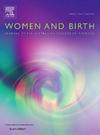失去亲人的父母参与共同设计的死产研究:参与项目的经验。
IF 4.4
2区 医学
Q1 NURSING
引用次数: 0
摘要
背景:虽然让消费者参与研究的好处是众所周知的,但失去亲人的父母面临着独特的挑战,并且缺乏对他们在共同设计的死产研究中的经验的描述。“参与项目”的集体经验包括共同设计资源,以支持失去亲人的父母参与研究。方法:本研究旨在描述和评估作为死产研究项目的共同调查者的丧偶父母的参与。采用描述性和探索性方法描述了2021年至2023年期间的“参与项目”过程,在这个过程中,失去亲人的父母参与了各个方面。通过反复回顾和反思来进行评估,以检查共同设计死胎研究的障碍和促进因素。研究结果:项目组共同设计并出版了《参与死产研究:丧亲父母指南》。七名共同研究人员完成了项目的最后阶段评估,其中包括五名失去亲人的父母和两名没有死产经历的研究人员。大多数共同调查人员认为他们的贡献受到高度重视,项目产出符合他们的期望。协同设计的促成因素包括清晰的沟通、共同的目标、支持性的团队、相关的产出以及团队中有实际经验的研究人员。障碍包括研究术语、满足后勤、支持和保持参与、角色期望和机构治理过程。结论:家长和研究人员都认为共同设计经验是积极的,并确定了许多促进团队成功的关键因素。评估丧失亲人的父母和研究者共同设计死产研究的经验是至关重要的。这里概述的过程和建议将指导未来参与死产研究的丧失亲人的父母的最佳做法。本文章由计算机程序翻译,如有差异,请以英文原文为准。
Bereaved parent involvement in co-designed stillbirth research: Experiences of Project Engage
Background
While benefits of involving consumers in research are well established, bereaved parents face unique challenges, and descriptions of their experiences with co-designed stillbirth research are lacking. The collective experience of ‘Project Engage’ involved co-designing resources to support bereaved parents’ involvement in research.
Methods
This study aimed to describe and evaluate the involvement of bereaved parents as co-investigators of a stillbirth research project. Descriptive and exploratory methods were used to describe the process of Project Engage, between 2021 and 2023, in which bereaved parents were involved in all aspects. Evaluation was performed through iterative review and reflection to examine barriers and enablers of co-designed stillbirth research.
Findings
The project team co-designed and published ‘Getting Involved in Stillbirth Research: A guide for bereaved parents’. Seven co-investigators completed the end-of-phase project evaluation, including five bereaved parents and two researchers without lived experience of stillbirth. Most co-investigators felt that their contribution was highly valued and that project outputs matched their expectations. Enablers of co-design included clear communication, having a shared goal, a supportive team, relevant outputs, and lived-experience researchers on the team. Barriers included research jargon, meeting logistics, support and maintaining engagement, role expectations, and institutional governance processes.
Conclusion
The co-design experience was perceived positively by both parents and researchers, with many key facilitators to the teams’ success identified. Evaluation of the experiences of bereaved parents and researchers co-designing stillbirth research is vital. The process and recommendations outlined here will guide future best practice for bereaved parent involvement in stillbirth research.
求助全文
通过发布文献求助,成功后即可免费获取论文全文。
去求助
来源期刊

Women and Birth
NURSING-OBSTETRICS & GYNECOLOGY
CiteScore
7.20
自引率
13.20%
发文量
371
审稿时长
27 days
期刊介绍:
Women and Birth is the official journal of the Australian College of Midwives (ACM). It is a midwifery journal that publishes on all matters that affect women and birth, from pre-conceptual counselling, through pregnancy, birth, and the first six weeks postnatal. All papers accepted will draw from and contribute to the relevant contemporary research, policy and/or theoretical literature. We seek research papers, quality assurances papers (with ethical approval) discussion papers, clinical practice papers, case studies and original literature reviews.
Our women-centred focus is inclusive of the family, fetus and newborn, both well and sick, and covers both healthy and complex pregnancies and births. The journal seeks papers that take a woman-centred focus on maternity services, epidemiology, primary health care, reproductive psycho/physiology, midwifery practice, theory, research, education, management and leadership. We also seek relevant papers on maternal mental health and neonatal well-being, natural and complementary therapies, local, national and international policy, management, politics, economics and societal and cultural issues as they affect childbearing women and their families. Topics may include, where appropriate, neonatal care, child and family health, women’s health, related to pregnancy, birth and the postpartum, including lactation. Interprofessional papers relevant to midwifery are welcome. Articles are double blind peer-reviewed, primarily by experts in the field of the submitted work.
 求助内容:
求助内容: 应助结果提醒方式:
应助结果提醒方式:


